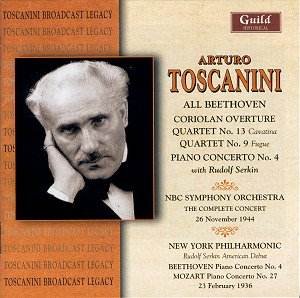Those of us who belong to that subspecies of
the human race homo musicalibus collector are a peculiar
lot. In my case it must go back to the time I lost forever the
only woman I have ever truly loved. She struck out at me, and
at my shock and hurt, she laughed ó and left me. I sought out
and drenched with my tears my motherís breast, and she with wisdom
soothed me: "Youíll meet many nice girls in your life my
son, especially next year when you start kindergarten ...."
However as the bitter years passed I resolved that if I could
never possess my true love, I could at least have six recordings
of Vaughan Williamsí Seventh Symphony. In time this became a pact
with ó God? Or the Devil? Does it matter? As everyone knows, not
to a record collector.
Anyway, itís been almost a year since I noted,
and remarked out loud, "I donít seem to have a single really
good recording of the Beethoven Fourth Piano Concerto..."
Someone was listening, and, mysteriously, recordings
began to come my way. And now has come to my attention this set
with not just one, but TWO recordings of the Beethoven Fourth
Piano Concerto in one box; and one of these is of the best performance
of the work Iíve ever heard, the second time in three months Iíve
had to ratchet up my standards.
Only a couple of little problems. Predictably,
the later concert with the better sound is not the best musically,
but the earlier concert with the better performance of the Beethoven
is at times very difficult to listen to. So, what youíre supposed
to do is listen to the old recording, gaps, dropouts and crackles
and all, and superimpose its musical values over the greater sonic
values of the later recording. If this makes sense to you, you
are a true dyed-in-the-wool record collector.
The Coriolan rehearsal from 1946 contains
a superb performance of the work, albeit in bits and pieces. The
sound is much better, also ó this is the Toscanini Beethoven of
the great RCA LP recordings that excited me so much when I was
getting to know this music during my college days. As to his rehearsal
technique, he seems to just lead them through, singing here and
there, screaming here and there. Itís after this when theyíre
working on details in string playing and ritardandi that
the real yelling starts. Without a libretto, you donít catch many
of the words, but I thought I heard a few vergognaís (shame!)
and some long invocations to saints. But me, I thought they played
it pretty well. What a shame the complete performance from 1944
is nowhere near this good, sounding hollow, rushed and uncommitted.
As to the other works on these disks, the less
said the better. The Mozart concerto is very well played but most
of the time barely audible through the hiss, crackle and audience
noise, with large gaps and level fluctuations as well. As a document
of how Toscanini and Serkin played the work together itís adequate,
but trying to enjoy the music is a struggle most of the time,
although the clouds clear dramatically for the third movement
cadenza and finale.
The two quartet movements have gained nothing
and lost quite a bit by being pumped up to full orchestral size.
The orchestra version of the cavatina from Op. 130 is played
with heavy portamento, achieving the rare miracle of sounding
at once both dragged out and rushed through; at odd times it resembles
a sketch for Wagnerís Siegfried Idyll. Then we hear the
Andante con moto introduction to the first movement of
Op. 59 #3 followed immediately by the allegro molto
fourth movement fugue which becomes a mad and unsuccessful
scramble by the string sections to keep up with the conductor.
Toscanini fans will want these, of course, but others, particularly
Beethoven fans, probably will not.
If you collect outstanding Beethoven Fourthís,
or are a dedicated fan of Toscanini and/or Serkin, youíll want
these disks. If in addition you have your own audio restoration
software, you may want to try your skill to do some cleaning up
on these noisy old recordings. If the Mozart concerto particularly
could be repaired and cleaned up significantly it could become
a recommended version.
Paul Shoemaker
